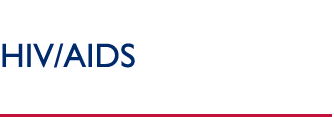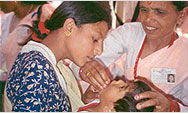USAID's Response: Children Affected by HIV/AIDS
The U.S. Agency for International
Development is committed to improving the lives of children
and families
affected by HIV/AIDS. In response to the growing crisis of
children orphaned by HIV/AIDS, USAID is currently funding
more than 99 activities in 21 countries to support children
affected by AIDS. These efforts continue more than a decade
of USAID activities that have addressed the needs of children
displaced or orphaned by armed conflict and HIV/AIDS. There
are three factors shaping USAID's response to the crisis
of
orphans and vulnerable children worldwide:
Magnitude. Worldwide, 13.4 million
children have lost one or both parents due to AIDS. Millions
more are living with parents who are ill or with families
that must stretch scarce resources to care for them. The
enormous scope of the crisis requires a rapid scaling up
of interventions, a broad resource base, and effective collaboration
to ensure the best use of resources.
Duration. By 2010, the number of
children who will have lost one or both parents due to HIV/AIDS
is projected to reach 25 million. That number will continue
to increase. Addressing the long-term needs of families
and communities affected by this crisis will require sustainable
interventions that will meet the needs of affected communities
for two or more decades.
Complexity. Children affected by HIV/AIDS suffer
from the stigma and discrimination associated with the disease,
the loss of caring adults, and depletion of household financial
resources. Interventions must go beyond health issues and
respond to the broad range of child and family needs.
USAID's Response
USAID is collaborating closely with
host country governments, citizen groups and other donors
toward the goal of providing community support to 25 percent
of HIV/AIDS-affected children in countries with a high-prevalence
of HIV/AIDS by 2007. USAID's activities emphasize helping
communities develop and sustain strategies to meet the needs
of vulnerable children by:
Strengthening the abilities of families to provide care
and support. A majority of USAID-supported projects aim
to increase a family's ability to provide care and support
to children affected by AIDS. In Kenya, the K-Rep project
provides vulnerable households with business training and
access to low-interest credit.
Mobilizing and supporting community-based responses.
For children whose families cannot adequately provide for
their basic needs, the community is the next safety net. Supporting
community-led initiatives to care for children and adolescents
affected by HIV/AIDS is a priority for USAID. The Community-based
Options for Protection and Empowerment, helps villages and
districts in Malawi form AIDS committees to raise funds and
provide support for home-based care, income generation, HIV
prevention, psychosocial support, and school fees for affected
families.
Helping children and adolescents meet their own needs.
USAID works to ensure that children and adolescents stay in
school, are trained in vocational skills, receive adequate
nutrition and receive health services. In Rwanda, Safety Net
currently reaches 7000 orphans, street children and others
to provide food aid.
Creating a supportive social and policy environment.
USAID is building the capacity of governments and community
organizations to protect the most vulnerable children and
provide essential services. USAID's activities implement a
variety of approaches to create supportive environments for
vulnerable children. These approaches include advocating for
basic legal protection, transforming public perceptions of
HIV/AIDS, and strengthening HIV/AIDS prevention and mitigation
efforts in the education sector.
Supporting research and information sharing. Donors,
governments, and community organizations need better information
about effective and sustainable programs. USAID supports research
to identify successful approaches. Recent activities include:
producing a guide for improving food security and nutrition
in HIV/AIDS-affected households; designing interventions to
address the physical and psychosocial needs of vulnerable
children; and studying the effectiveness of interventions
to help parents and families plan for their children's future
care.
Orphanages Are Not the Solution
- Care provided in institutional settings often fails
to meet the developmental needs of children. Children
benefit greatly from the care, personal attention, and
social connections that families and communities can provide.
Children raised in orphanages often have difficulty re-entering
society once they reach adulthood, and many are poorly
equipped to fend for themselves in the outside world.
- Maintaining orphanages is much more expensive than providing
direct assistance to families and communities to care
for orphaned children. Cost comparisons from Uganda show
operating costs for orphanages to be 14 times higher than
those for community care.
- In communities under severe economic stress, increasing
the numbers of orphanages often results in the removal
of children from households.
The vast majority of children affected
by HIV/AIDS orphans live in their extended families and communities.
In areas with high HIV/AIDS prevalence, these families and
communities face increasing strains on their capacity to care
for affected children. USAID support in these areas can help
children stay in their communities and assist with their health
care, education, food security, housing, and psychosocial
support.
» |


